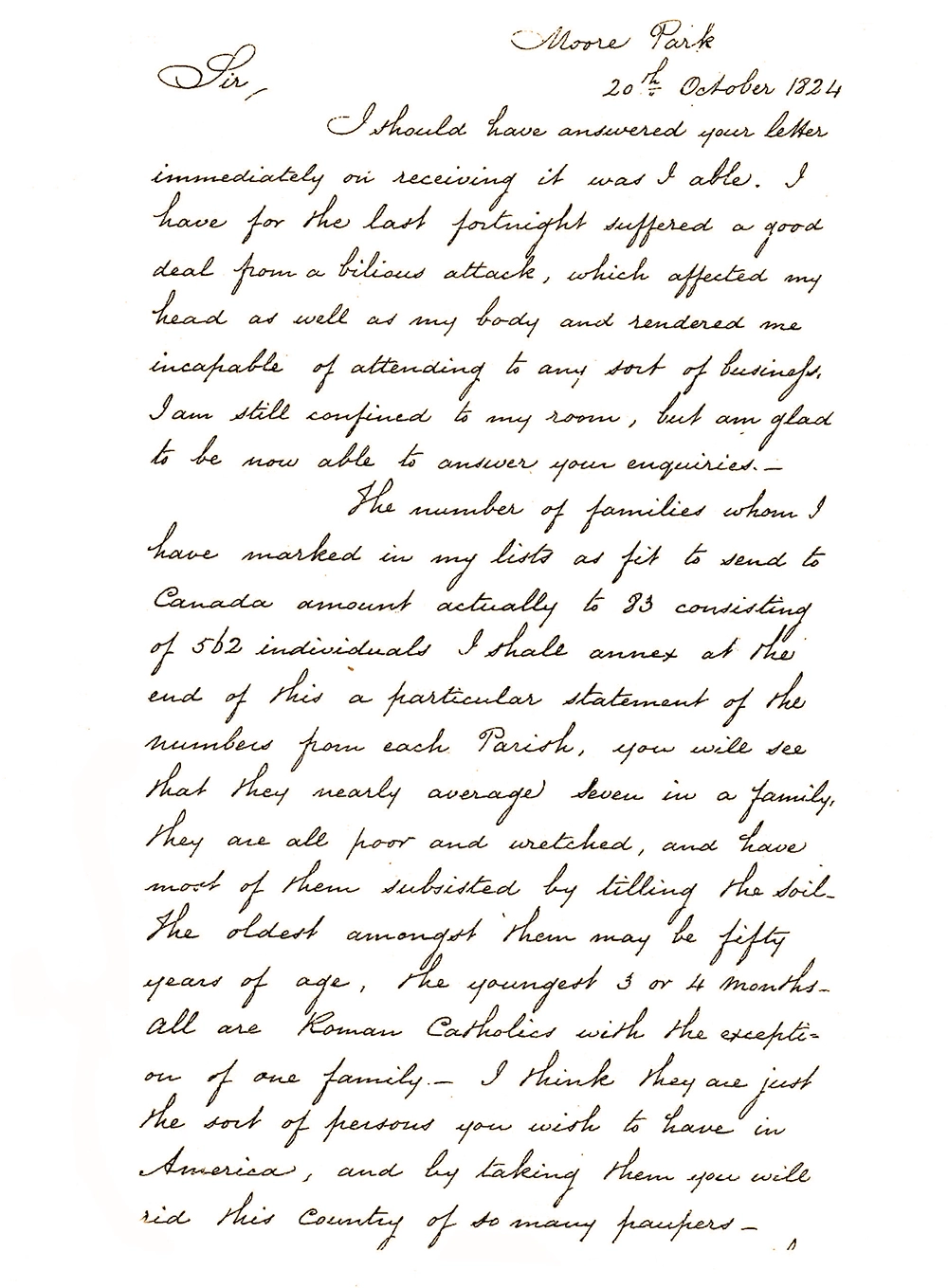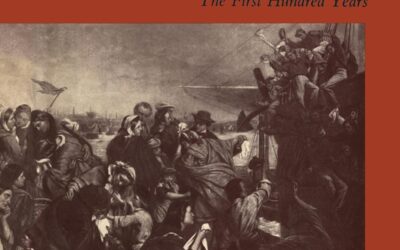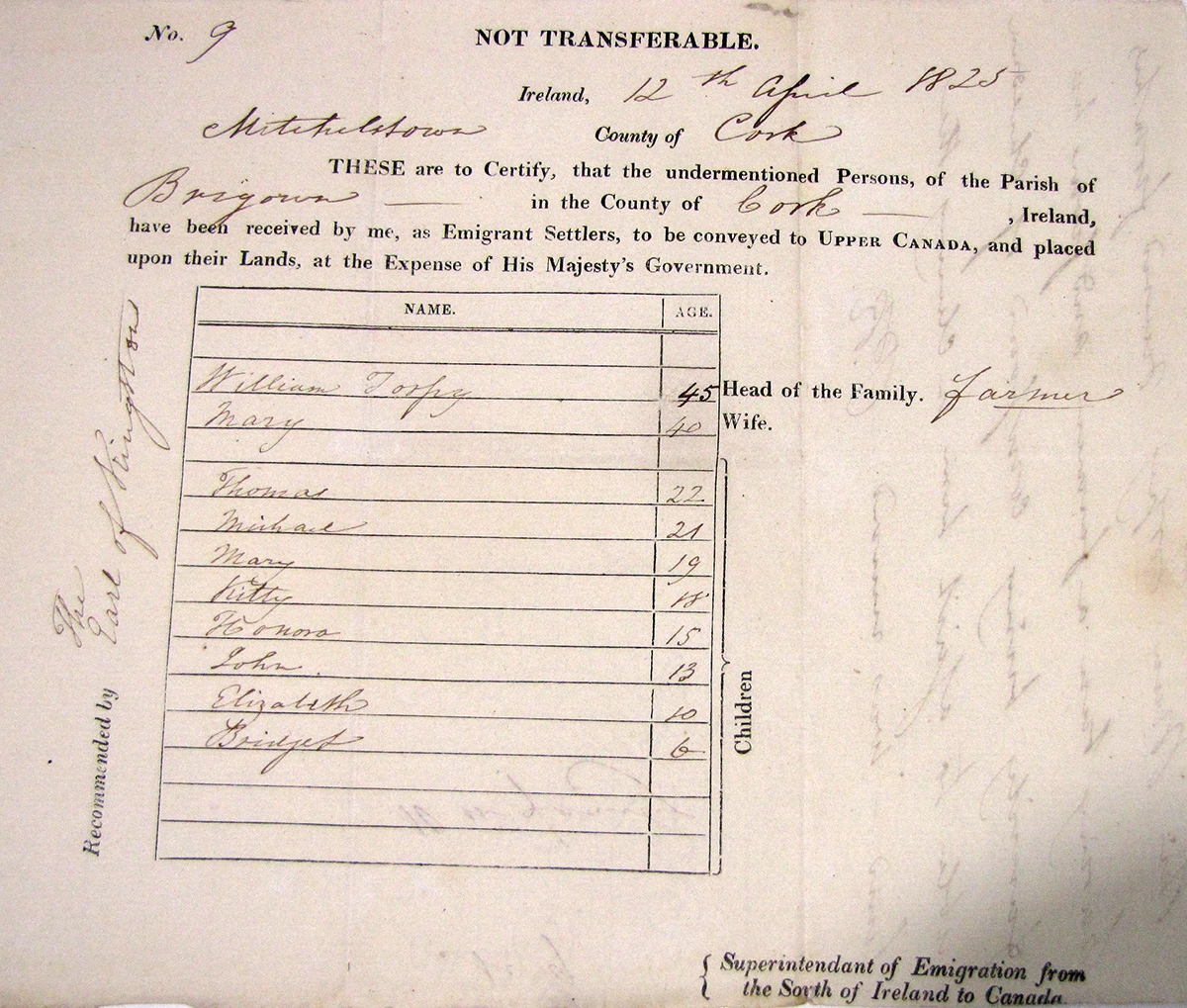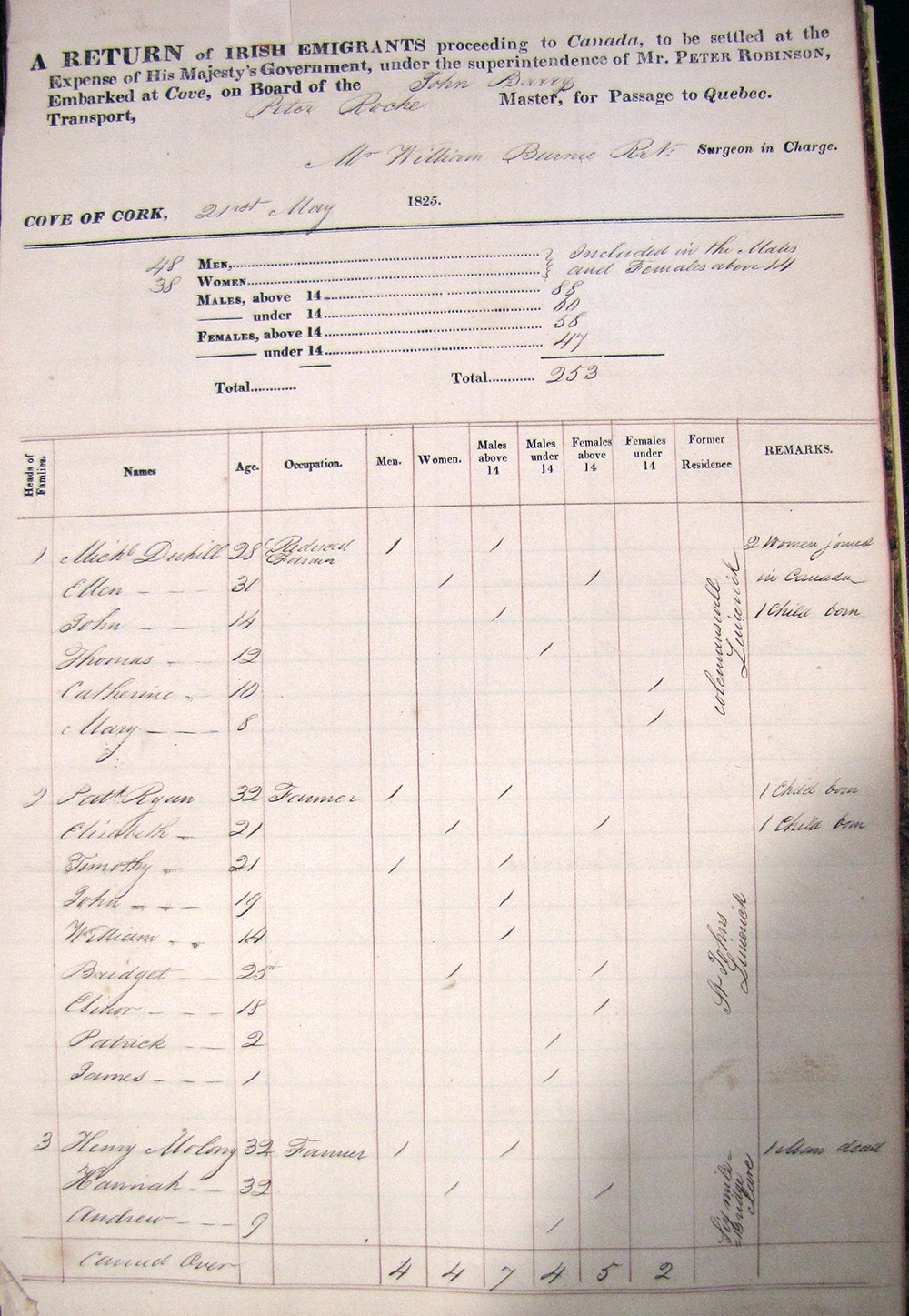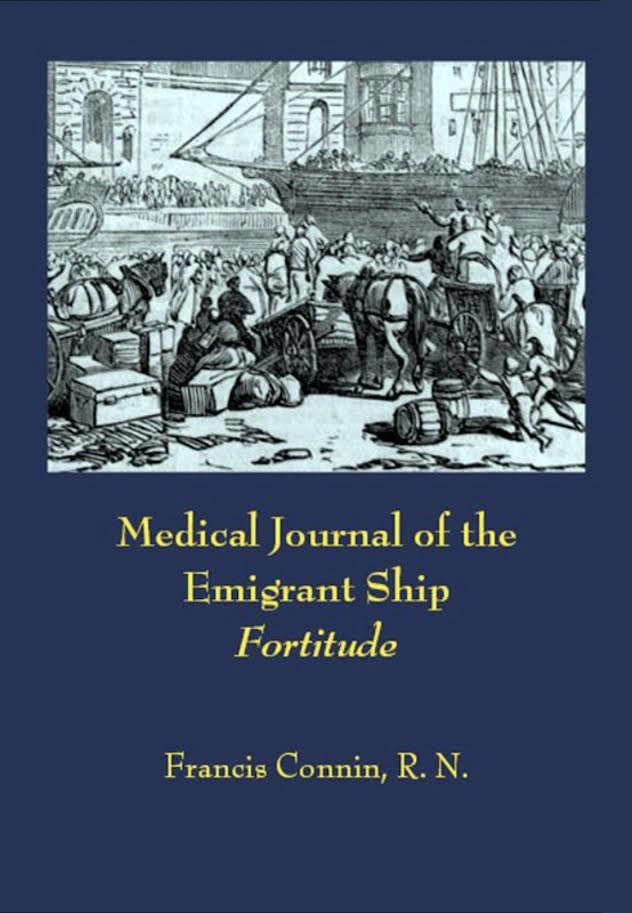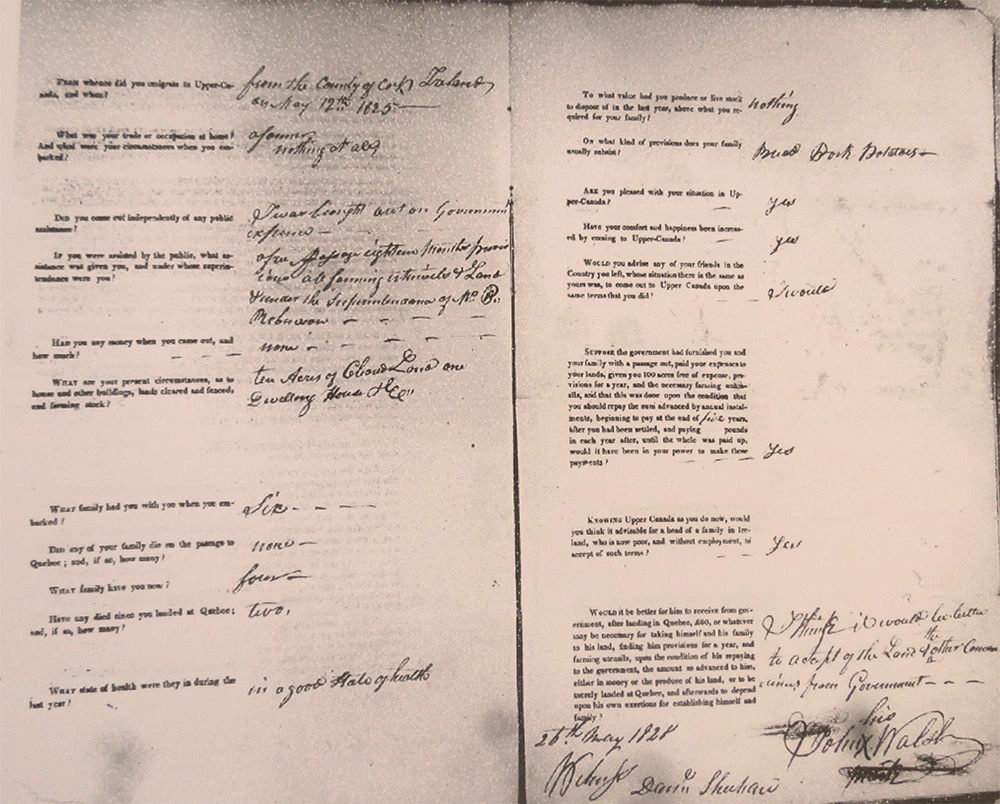Research and Publications
Historical Insights and Contributions
Welcome to our Research and Publications page!
This page is dedicated to providing accurate and comprehensive information about the Peter Robinson Emigration. We plan to continually update this resource with biweekly or monthly contributions from members of the Nine Ships and other researchers. Our goal is to be a launching point for anyone interested in delving deeper into this significant historical event.
We extend our heartfelt thanks to Dennis Carter-Edwards, a dedicated member of the Nine Ships, for his insightful bibliographic essay featured below.
We also invite anyone interested in contributing to this page to connect with us via email through our contact page or in person at our upcoming events. Your participation helps us preserve and share the rich history of the Peter Robinson Emigration with our community and beyond.
Historical Narratives & Bonus Content
Enjoy and explore a variety of new content as we dive deeper into archives and other narratives. Here will will post our book and resource reviews and other unique content that has been unearthed by the committee, decendants, and locals. Stay tuned as we will be updating this section biweekly.
The Peterborough Examiner – Opinion | Peter Robinson and my golfing life an article by Paul Hickey
Click the link below to be taken to opinion article by...
VIDEO: Peter Robinson Irish Emigration Bicentennial Presentation – January 21, 2025
On January 21, 2025, Nine...
British Emigration History Book Review by Elwood H. Jones
Helen I. Cowan, British Emigration to British North...
A Bibliographic Essay of Key Primary and Secondary Sources For the 1825 British Sponsored Irish Migration to Peterborough
By Dennis Carter-Edwards
In 2025 Peterborough and the surrounding communities will commemorate the 200th anniversary of the migration of some 2,000 British sponsored Irish immigrants to the Peterborough region. To assist those who may be looking for more information on this unique migration story, this brief bibliographic essay highlights some of the key primary and secondary sources that provide both a context for and insights into the events leading up to the creation of the plan by Wilmot Horton, the execution of the plan under the supervision of Peter Robinson and the experience of the Irish settlers who made the decision to leave their known world and venture to a new land.
The story of the migration of some 2,000 Irish to the Peterborough region in 1825 has been the subject of numerous academic studies and family genealogical projects. They all draw on an extensive body of original documents and primary materials that is unique in the annals of migration history to Canada, if not beyond. The core of this collection are the records generated by and for Peter Robinson. These records remained with the Robinson family until they were donated to the local Historical Society and were placed first with the Peterborough Public Library and then with the Archives of Ontario before being placed in the Peterborough Museum and Archives as the Peter Robinson papers (PMA) MG71-017where they may be accessed through contact with the city Archivist. Two key records within the collection are of special interest: the Embarkation Certificates (Figure 1) which were issued to the families selected by Robinson and the Ship Rosters (Figure 2) which details the families that boarded the nine vessels that brought the immigrants from Cobh in May 1825. These records are of importance because they provide not only the names and ages of the members of families but who sponsored them, the parish and county where they lived, the male’s occupation, where they eventually settled and often brief comments on their circumstances as well as the ship they sailed on. From these records it is possible to trace individual families, their place of origin and their sponsor – often one of the large landowners where they were tenant farmers and the lot and concession number of the township where they eventually settled. The Robinson papers also contain a large collection of original letters of application and or recommendations in support of a family’s request to be included in the plan. (Figure 3) Other useful records include Robinson’s correspondence with government officials on the progress of the planning and execution of the immigration scheme, especially with Under Secretary of State for the Colonies Wilmot Horton, along with financial records that relate to the cost of the scheme. There are also records that document the rations and supplies issued to settlers, names of families who settled in the various townships, their agricultural output, medical reports on the health of the settlers and other miscellaneous records related to settlement.
While the Robinson papers at the PMA represent the most significant primary source there are other valuable collections that shed light on the families. Each of the nine ships that embarked from Cobh had a medical officer on board who recorded his treatment of the patients he dealt with, often adding his own personal observations on the character of their patients or conditions on board the ship during the crossing. Some of these journals have been transcribed and are available for purchase through Paul Allen’s www.allens-ucs.com. (Figure 4) The British government held formal committee hearings on the broad topic of immigration, The testimony presented, while difficult to access, offers additional commentary on the pros and cons of the migration scheme. Wilmot Horton remained a fervent advocate of immigration to address social issues in Britain and commissioned a survey of the immigrants a few years after they were settled. The completed questionnaires have been digitally reprinted through the Peannairi project. (Figure 5) Collectively these diverse, original documentary sources on the 1825 British sponsored immigration scheme constitutes one of the most comprehensive sources for immigration to Canada and are critical for supporting the Bicentennial commemoration of the Robinson settlers.
The secondary sources that concern the topic of immigration are twofold, general and specific. There are numerous general studies that discuss the situation in Ireland prior to and during the massive Famine migration mid century such as J. Donnelly The Land and the People of Nineteenth Century Cork: The Rural Economy and the Land Question (Routledge & Kegan Paul, London 1975). David Dickson, Old World Colony: Cork and South Munster 1630-1830 (University of Wisconsin, 2005) or H. Johnston British Emigration Policy 1815-1830: Shovelling out Paupers (Clarendon Press, Oxford 1972). These, more academically focused studies and their useful bibliographies, may be difficult to access through public libraries but should be available through inter-library loan. Along side these studies are publications that provide an overview of migration to Canada such as H. Cowan, Emigration to British North America (Toronto, University of Toronto Press, 1928) and H. Manion Irish Settlements in Eastern Canada (Toronto, University of Toronto Press, 1974). There are numerous publications that describe in general terms pioneer life in Upper Canada such as Jean Minhinnick At Home in Upper Canada (Clarke Irwin, Toronto 1970) which provide a general context for the experiences faced by the pioneering Robinson settlers.
The other general grouping of secondary sources are those studies both books and articles that deal specifically with the British sponsored migration under Peter Robinson. Township histories of Peterborough County, many published as centennial projects in the 1960s such as Through the Years in Douro 1822-1867 (Peterborough, A.D. Newson Co., 1967) contain sections of varying length and analysis on the Robinson migration. Dr. T.W. Poole The Early Settlement of Peterborough County (Peterborough, Peterborough Printing Company, reprint 1967) was an early attempt to record the city’s early history and devotes a full chapter to the 1825 migration. These general studies provide valuable local context and some detailed family histories that compliment the more general histories. More recently, there are websites and face book pages that provide on line genealogical information of varying quality and accuracy to guide both novice and experts tracing their Robinson ancestors. However, the focus of this bibliographic essay is on the specific books and articles that deal directly with the Robinson led migration project. It is hoped this will guide the general reader, family genealogist or the curious to discover this fascinating story and consider participating in the many events being planned by The Nine Ships 1825 Inc to commemorate the bicentennial in 2025.
The secondary sources that concern the topic of immigration are twofold, general and specific. There are numerous general studies that discuss the situation in Ireland prior to and during the massive Famine migration mid century such as J. Donnell The Land and the People of Nineteenth Century Cork: The Rural Economy and the Land Question (Routland & Kegan Paul, London 1875) or H. Johnston British Emigration Policy 1815-1830: Shovelling out Paupers (Clarendon Press, Oxford 1972). These, more academically focused studies and their useful bibliographies, may be difficult to access through public libraries but should be available through inter-library loan. Along side these studies are publications that provide an overview of migration to Canada such as H. Cowan, Emigration to British North America (University of Toronto Press, Toronto 1928) and H. Manion Irish Settlements in Eastern Canada (University of Toronto Press, Toronto 1974). There are numerous publications that describe in general terms pioneer life in Upper Canada such as Jean Manhinnick At Home in Upper Canada (Clarke Irwin, Toronto 1970) which provide a general context for the experiences faced by the pioneering Robinson settlers.
The other general grouping of secondary sources are those studies both books and articles that deal specifically with the British sponsored migration under Peter Robinson. Township histories of Peterborough County, many published as centennial projects in the 1960s such as Through the Years in Douro 1822-1867 (A.D. Newson Co., Peterborough 1967) or local histories such as Yesteryear at Young’s Point (Custom Printers, Renfrew nd) contain sections of varying length and analysis on the Robinson migration. Dr. T.W. Poole The Early Settlement of Peterborough County (Peterborough Printing Company, Peterborough reprint 1967) was an early attempt to record the city’s early history and devotes a full chapter to the 1825 migration. These general studies provide valuable local context and some detailed family histories that compliment the more general histories. More recently, there are websites and Facebook pages that provide online genealogical information of varying quality and accuracy to guide both novice and experts tracing their Robinson ancestors. However, the focus of this bibliographic essay is on the specific books and articles that deal directly with the Robinson led migration project. It is hoped this essay will guide the general reader, family genealogist or the curious to discover this fascinating story and consider participating in the many events being planned by The Nine Ships 1825 Inc to commemorate the bicentennial in 2025.
Sources
Queen’s University, 1934.
[2] Ibid., “Assisted Emigration from Ireland to Upper Canada under Peter Robinson in 1825,) Ontario Historical Society Papers and Records, Vol.XXI, (1936), pp.178-214.
[3] Peter and Monica Maltby, “A New Look at the Peter Robinson Emigration of 1823,” Ontario History, Vol.LV, No.1 (1963), p.15-22.
[4] Wendy Cameron, “Selecting Peter Robinson’s Irish Emigrants,” Histoire Sociale – Social History, Vol.9, No17 (1976), pp29-46.
[5] Guy Ferguson, “The Peter Robinson Settlers in Emily Township 1825-1861,” M.A. Thesis, Queen’s University, 1979.
[6] Alan Brunger, “Geographical propinquity among pre-famine Catholic Irish settlers in Upper Canada,” Journal of Historical Geography, 8, 3 (1982), pp.165-282.
[7] Elaine Devlin, “Ancestral, Religious and Kinship Links in Douro and Northern Otonabee Townships” a Thesis submitted to the Department of Geography Trent University 1993.
[8] Carol Bennett, Peter Robinson Settlers 1823 1825, (Renfrew, Juniper Books Ltd.,1987)
[9] Dennis Carter-Edwards, “Loyal and Grateful Subjects of the King: The 1825 Irish Migration to Peterborough,” in Australasian Canadian Studies, Vol. 34, No.1-2 (2017),pp.3-30.
[10] The Examiner (Peterborough), July 2015.
[11] Rosemary and Peter McConkey, “The Robinson Settlers of Douro,” Heritage Gazette of the Trent Valley, Vol.25, No.3 (November 2020).
[12] Rosemary Anne McConkey, Green Routes Experiencing the Peter Robinson Emigration, Trent Valley Archives. 2023.
[13] D. Carter-Edwards, “Researching Records of the 1825 British Sponsored Irish Migration to Peterborough: A Cautionary Tale,” Heritage Gazette of the Trent Valley, Vol.24, No.4 (February 2020).
More places to find information on the Peter Robinson Emigration of 1825
Peterborough Museum and Archives - Peter Robinson Papers
Peter Robinson Papers
PETERBOROUGH MUSEUM AND ARCHIVES, Fonds 71-017; formerly MG 1731
Peter Robinson fonds
1823 1844
52cm of textual records and other material; 4 boxes; 1650 pages
BIOGRAPHY / HISTORY: Between 1823 and 1825 two large groups of impoverished Irish people were brought to Upper Canada under an emigration plan proposed by the British government. The Hon. Peter Robinson (1785-1 838) was appointed to implement this experimental plan. Thousands of Irish families applied to settle in the New World, beginning in 1823. The 1823 emigrants settled in the Bathursi District, (eastern Ontario). The second group left Ireland in 1825, bound for Peterborough County (Newcastle District). Some 2000 people made the journey in 9 ships.
SCOPE AND CONTENT:
A comprehensive fonds that documents the 1823 and I 825emigration of Irish Catholic settlers to Upper Canada under Peter Robinson.
‘I’he fonds includes: original ship lists; general Robinson correspondence (1823-1843); embarkation certificates which includes names, ages. parish of each family (1825): applications and certificates of recommendation; location tickets for settlers (1823); schedule of location of the 1823-25 emigrants;
list of settlers and supplies of tools, clothing, livestock and other goods provided upon arrival (by township); ship surgeons reports (1825); account books (1825, 1844); questionnaires completed by emigrants (1828); assorted other papers; original poster announcing the Robinson emigration to Canada, dated at Cork, 1825.
The Peter Robinson Papers were originally donated to the Victoria Museum by Christopher Robinson, a nephew of Peter Robinson. Later, the Public Library Board transferred the papers to the Archives of Ontario. By 1957, the new Peterborough Historical Society was beginning to rebuild a museum collection. The Historical Society hoped to acquire the Robinson papers. After years of negotiations, the Robinson Papers were formally “repatriated” to the Archives in 1971.
Restrictions: open access
Finding Aid: yes
Related Accession(s): 59-010
Accruals Possible: Accruals are not expected.
1971-017 Peter Robinson Papers
A) Embarkation Certificates — 1825
B) Applications & Certificates of Recommendation
C) Correspondence, 1823-43
D) Emigrants Embarked on the Hebe and Stakesby, 1823
E) Location Tickets for Settlers, District of Bathurst, 1823
F) Emigrants Located in Townships of Ramsay, Pakenhan and Huntley, 1823
G) Schedule of Location, 1823 (Bound Volume)
H) Returns of Emigrants Embarked at Cork, 1825
J) Families according to Townships – Douro, Smith and Emily, 1825
K) List of Families according to Townships, 1825 (copy similar to Series J but with some differences)
L) Register of Goods to Settlers, 1825
M) Account Book, 1825
N) Schedule of Purchases of Lots in Peterborough County, 1844
0) Account Book, 1844
P) General Material Concerning Robinson’s
